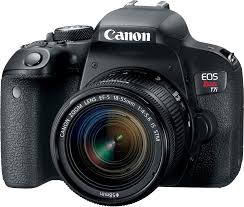
With people watching more video on Facebook than they do on YouTube, visual content has become the lay of the land for brands, celebrities and non-profits alike. In fact, video is worth more than a thousand words – according to Forrester Research, one minute of video is worth 1.8 million words!
The verdict is clear: leveraging visual content for your association is truly the best way to reach potential members and engage your current membership.
While smartphones can capture great photo and video, there are affordable options out there that can lead to high-quality results. DSLR cameras are not only the perfect entry point for beginners, they’re also favored by professionals in the video production field.
What is a DSLR camera?
DSLR stands for Digital Single-Lens Reflex, having widely replaced SLR, or single-lens reflex, cameras in the 2000s. These cameras contain a mirror inside that reflects light from the lens into an optical viewfinder, by way of a prism or additional mirrors.
With more professional features than a point-and-shoot camera (the go-to choice for family vacation pictures before smartphones came around), DSLR cameras became a necessity for aspiring photographers. When high-definition DSLRs were introduced at the turn of the decade, capturing high-quality video became widely accessible.
Why use DSLR?
While most people are familiar with using camcorders for video recording, DSLR cameras offer many advantages. For example, they:
- Have interchangeable lenses
- Capture pristine photo and video in low-light environments (and we all know office lighting isn’t always the best)
- Work well with a shallow depth-of-field (when the subject is in sharp focus and the background is blurred, which works well for interviewing)
- Are lighter than professional shoulder-mount video cameras
DSLRs have also become more and more affordable as technology has advanced, setting them apart from competitors (like digital mirrorless cameras or camcorders).
Cons of DSLRs
Like any camera, DSLRs do their own disadvantages. To shoot steadier video at a board meeting or conference, you might want to invest in a shoulder rig, gimbal or tripod, which can all range in price from affordable (under $50) to very high-end (a professional video producer might spend over a thousand).
It can be slightly more difficult to capture audio with a DSLR camera when compared to a camcorder, but microphones or external sound recorders can offset the potential of that problem. An iPhone can even be used as a microphone.
Getting started
Ready to take the plunge and invest in a DSLR camera to better engage current and prospective members? It can be daunting when search results are flooded with ads, reviews, and ads disguised as reviews, but there are plenty of resources to help inform your decision:
- B&H, a leading photo and video retailer, recommends seven entry-level DSLRs.
- CNET highlights the best DSLR cameras for beginners in 2019.
- TechRadar offers 10 cheap DSLRs for the novice user.
Expanding into video production and editing is undoubtedly an advantageous way to widen your association’s footprint. A DSLR camera will make that goal easier with its affordability, capability, and versatility. Scared to dive in? Try a video tutorial – after all, video is the future.
This Article was written by
It is a long established fact that a reader will be distracted by the readable content of a page when looking at its layout. The point of using Lorem Ipsum is that it has a more-or-less normal distribution of letters.
